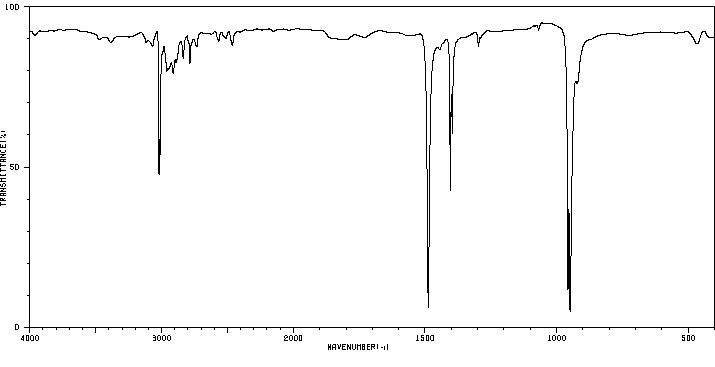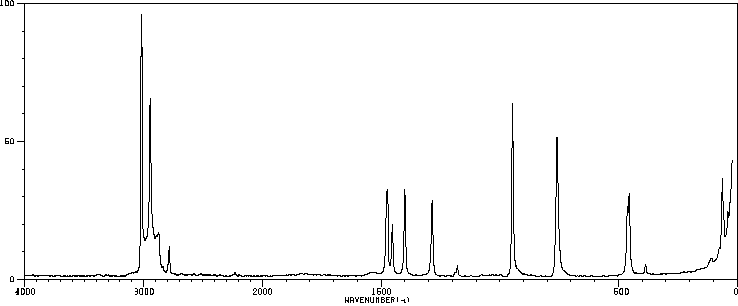四甲基溴化铵 | 64-20-0
中文名称
四甲基溴化铵
中文别名
溴化四甲基铵;溴化四甲烷;四甲胺溴化物;四甲替溴化铵;溴化四甲铵;四甲基溴化胺
英文名称
tetramethylammonium bromide
英文别名
TMAB;N,N,N,N-tetramethylammonium bromide;tetramethylazanium;bromide
CAS
64-20-0
化学式
Br*C4H12N
mdl
——
分子量
154.05
InChiKey
DDFYFBUWEBINLX-UHFFFAOYSA-M
BEILSTEIN
——
EINECS
——
-
物化性质
-
计算性质
-
ADMET
-
安全信息
-
SDS
-
制备方法与用途
-
上下游信息
-
文献信息
-
表征谱图
-
同类化合物
-
相关功能分类
-
相关结构分类
物化性质
-
熔点:>300 °C (lit.)
-
沸点:>360°C
-
密度:1,56 g/cm3
-
溶解度:在水中的溶解度0.1 g/mL,澄清,无色
-
最大波长(λmax):λ: 240 nm Amax: 0.06λ: 250 nm Amax: 0.03λ: 260 nm Amax: 0.02λ: 500 nm Amax: 0.02
计算性质
-
辛醇/水分配系数(LogP):-2.67
-
重原子数:6
-
可旋转键数:0
-
环数:0.0
-
sp3杂化的碳原子比例:1.0
-
拓扑面积:0
-
氢给体数:0
-
氢受体数:1
安全信息
-
TSCA:Yes
-
危险等级:6.1
-
危险品标志:T
-
安全说明:S26,S28,S28A,S36,S37/39,S45
-
危险类别码:R36/37/38,R25
-
WGK Germany:3
-
海关编码:29239000
-
危险品运输编号:UN 2811 6.1/PG 2
-
危险类别:6.1
-
RTECS号:BS7600000
-
包装等级:II
-
危险标志:GHS06
-
危险性描述:H300,H315,H319,H335
-
危险性防范说明:P261,P264,P301 + P310,P305 + P351 + P338
-
储存条件:本品应密封干燥保存,并存放在阴凉、干燥的地方,最好置于密闭容器中。
SDS
四甲基溴化铵 修改号码:5
模块 1. 化学品
产品名称: Tetramethylammonium Bromide
修改号码: 5
模块 2. 危险性概述
GHS分类
物理性危害 未分类
健康危害
急性毒性(经口) 第2级
皮肤腐蚀/刺激 第2级
严重损伤/刺激眼睛 2A类
环境危害 未分类
GHS标签元素
图标或危害标志
信号词 危险
危险描述 吞咽致命。
造成皮肤刺激
造成严重眼刺激
防范说明
[预防] 使用本产品时切勿吃东西,喝水或吸烟。
处理后要彻底清洗双手。
穿戴防护手套/护目镜/防护面具。
[急救措施] 食入:立即呼叫解毒中心/医生。
眼睛接触:用水小心清洗几分钟。如果方便,易操作,摘除隐形眼镜。继续冲洗。
眼睛接触:求医/就诊
皮肤接触:用大量肥皂和水轻轻洗。
若皮肤刺激:求医/就诊。
脱掉被污染的衣物,清洗后方可重新使用。
[储存] 存放处须加锁。
[废弃处置] 根据当地政府规定把物品/容器交与工业废弃处理机构。
四甲基溴化铵 修改号码:5
模块 3. 成分/组成信息
单一物质/混和物 单一物质
化学名(中文名): 四甲基溴化铵
百分比: >97.0%(T)
CAS编码: 64-20-0
分子式: C4H12BrN
模块 4. 急救措施
吸入: 将受害者移到新鲜空气处,保持呼吸通畅,休息。若感不适请求医/就诊。
皮肤接触: 立即去除/脱掉所有被污染的衣物。用大量肥皂和水轻轻洗。
若皮肤刺激或发生皮疹:求医/就诊。
眼睛接触: 用水小心清洗几分钟。如果方便,易操作,摘除隐形眼镜。继续清洗。
如果眼睛刺激:求医/就诊。
食入: 立即呼叫解毒中心/医生。漱口。
紧急救助者的防护: 救援者需要穿戴个人防护用品,比如橡胶手套和气密性护目镜。
模块 5. 消防措施
合适的灭火剂: 干粉,泡沫,雾状水,二氧化碳
特殊危险性: 小心,燃烧或高温下可能分解产生毒烟。
特定方法: 从上风处灭火,根据周围环境选择合适的灭火方法。
非相关人员应该撤离至安全地方。
周围一旦着火:如果安全,移去可移动容器。
消防员的特殊防护用具: 灭火时,一定要穿戴个人防护用品。
模块 6. 泄漏应急处理
个人防护措施,防护用具, 使用特殊的个人防护用品(针对有毒颗粒的P3过滤式空气呼吸器)。远离溢出物/泄露
紧急措施: 处并处在上风处。
泄露区应该用安全带等圈起来,控制非相关人员进入。
环保措施: 防止进入下水道。
控制和清洗的方法和材料: 清扫收集粉尘,封入密闭容器。注意切勿分散。附着物或收集物应该立即根据合适的
法律法规处置。
模块 7. 操作处置与储存
处理
技术措施: 在通风良好处进行处理。穿戴合适的防护用具。防止粉尘扩散。处理后彻底清洗双手
和脸。
注意事项: 如果可能,使用封闭系统。如果粉尘或浮质产生,使用局部排气。
操作处置注意事项: 避免接触皮肤、眼睛和衣物。
贮存
储存条件: 保持容器密闭。存放于凉爽、阴暗处。
存放于惰性气体环境中。
防湿。
存放处须加锁。
远离不相容的材料比如氧化剂存放。
易湿
包装材料: 依据法律。
模块 8. 接触控制和个体防护
工程控制: 尽可能安装封闭体系或局部排风系统。同时安装淋浴器和洗眼器。
个人防护用品
四甲基溴化铵 修改号码:5
模块 8. 接触控制和个体防护
呼吸系统防护: 防尘面具,自携式呼吸器(SCBA),供气呼吸器等。使用通过政府标准的呼吸器。依
据当地和政府法规。
手部防护: 防渗手套。
眼睛防护: 护目镜。如果情况需要,佩戴面具。
皮肤和身体防护: 防渗防护服。如果情况需要,穿戴防护靴。
模块 9. 理化特性
固体
外形(20°C):
外观: 晶体-粉末
颜色: 白色类白色
气味: 无资料
pH: 4.0 - 7.0 (50g/L H2O soln.)
熔点: 无资料
沸点/沸程 无资料
闪点: 无资料
爆炸特性
爆炸下限: 无资料
爆炸上限: 无资料
密度: 无资料
溶解度:
[水] 溶于
[其他溶剂]
极微溶于: 乙醇
不溶于: 醚, 氯仿
模块 10. 稳定性和反应性
化学稳定性: 一般情况下稳定。
危险反应的可能性: 未报道特殊反应性。
须避免接触的物质 氧化剂
危险的分解产物: 一氧化碳, 二氧化碳, 氮氧化物 (NOx), 溴化氢
模块 11. 毒理学信息
急性毒性: ipr-rat LD50:24600 ug/kg
ivn-mus LD50:1800 ug/kg
orl-mus LD50:118 mg/kg
orl-rat LD50:50 mg/kg
对皮肤腐蚀或刺激: 无资料
对眼睛严重损害或刺激: 无资料
生殖细胞变异原性: 无资料
致癌性:
IARC = 无资料
NTP = 无资料
生殖毒性: 无资料
RTECS 号码: BS7600000
模块 12. 生态学信息
生态毒性:
鱼类: 无资料
甲壳类: 无资料
藻类: 无资料
四甲基溴化铵 修改号码:5
模块 12. 生态学信息
残留性 / 降解性: 无资料
潜在生物累积 (BCF): 无资料
土壤中移动性
log水分配系数: 无资料
土壤吸收系数 (Koc): 无资料
亨利定律 无资料
constaNT(PaM3/mol):
模块 13. 废弃处置
如果可能,回收处理。请咨询当地管理部门。建议在可燃溶剂中溶解混合,在装有后燃和洗涤装置的化学焚烧炉中
焚烧。废弃处置时请遵守国家、地区和当地的所有法规。
模块 14. 运输信息
联合国分类: 第1项 毒害品。
UN编号: 2811
正式运输名称: 有毒固体, 有机物, 不另作详细说明
包装等级: II
模块 15. 法规信息
《危险化学品安全管理条例》(2002年1月26日国务院发布,2011年2月16日修订): 针对危险化学品的安全使用、
生产、储存、运输、装卸等方面均作了相应的规定。
模块16 - 其他信息
N/A
模块 1. 化学品
产品名称: Tetramethylammonium Bromide
修改号码: 5
模块 2. 危险性概述
GHS分类
物理性危害 未分类
健康危害
急性毒性(经口) 第2级
皮肤腐蚀/刺激 第2级
严重损伤/刺激眼睛 2A类
环境危害 未分类
GHS标签元素
图标或危害标志
信号词 危险
危险描述 吞咽致命。
造成皮肤刺激
造成严重眼刺激
防范说明
[预防] 使用本产品时切勿吃东西,喝水或吸烟。
处理后要彻底清洗双手。
穿戴防护手套/护目镜/防护面具。
[急救措施] 食入:立即呼叫解毒中心/医生。
眼睛接触:用水小心清洗几分钟。如果方便,易操作,摘除隐形眼镜。继续冲洗。
眼睛接触:求医/就诊
皮肤接触:用大量肥皂和水轻轻洗。
若皮肤刺激:求医/就诊。
脱掉被污染的衣物,清洗后方可重新使用。
[储存] 存放处须加锁。
[废弃处置] 根据当地政府规定把物品/容器交与工业废弃处理机构。
四甲基溴化铵 修改号码:5
模块 3. 成分/组成信息
单一物质/混和物 单一物质
化学名(中文名): 四甲基溴化铵
百分比: >97.0%(T)
CAS编码: 64-20-0
分子式: C4H12BrN
模块 4. 急救措施
吸入: 将受害者移到新鲜空气处,保持呼吸通畅,休息。若感不适请求医/就诊。
皮肤接触: 立即去除/脱掉所有被污染的衣物。用大量肥皂和水轻轻洗。
若皮肤刺激或发生皮疹:求医/就诊。
眼睛接触: 用水小心清洗几分钟。如果方便,易操作,摘除隐形眼镜。继续清洗。
如果眼睛刺激:求医/就诊。
食入: 立即呼叫解毒中心/医生。漱口。
紧急救助者的防护: 救援者需要穿戴个人防护用品,比如橡胶手套和气密性护目镜。
模块 5. 消防措施
合适的灭火剂: 干粉,泡沫,雾状水,二氧化碳
特殊危险性: 小心,燃烧或高温下可能分解产生毒烟。
特定方法: 从上风处灭火,根据周围环境选择合适的灭火方法。
非相关人员应该撤离至安全地方。
周围一旦着火:如果安全,移去可移动容器。
消防员的特殊防护用具: 灭火时,一定要穿戴个人防护用品。
模块 6. 泄漏应急处理
个人防护措施,防护用具, 使用特殊的个人防护用品(针对有毒颗粒的P3过滤式空气呼吸器)。远离溢出物/泄露
紧急措施: 处并处在上风处。
泄露区应该用安全带等圈起来,控制非相关人员进入。
环保措施: 防止进入下水道。
控制和清洗的方法和材料: 清扫收集粉尘,封入密闭容器。注意切勿分散。附着物或收集物应该立即根据合适的
法律法规处置。
模块 7. 操作处置与储存
处理
技术措施: 在通风良好处进行处理。穿戴合适的防护用具。防止粉尘扩散。处理后彻底清洗双手
和脸。
注意事项: 如果可能,使用封闭系统。如果粉尘或浮质产生,使用局部排气。
操作处置注意事项: 避免接触皮肤、眼睛和衣物。
贮存
储存条件: 保持容器密闭。存放于凉爽、阴暗处。
存放于惰性气体环境中。
防湿。
存放处须加锁。
远离不相容的材料比如氧化剂存放。
易湿
包装材料: 依据法律。
模块 8. 接触控制和个体防护
工程控制: 尽可能安装封闭体系或局部排风系统。同时安装淋浴器和洗眼器。
个人防护用品
四甲基溴化铵 修改号码:5
模块 8. 接触控制和个体防护
呼吸系统防护: 防尘面具,自携式呼吸器(SCBA),供气呼吸器等。使用通过政府标准的呼吸器。依
据当地和政府法规。
手部防护: 防渗手套。
眼睛防护: 护目镜。如果情况需要,佩戴面具。
皮肤和身体防护: 防渗防护服。如果情况需要,穿戴防护靴。
模块 9. 理化特性
固体
外形(20°C):
外观: 晶体-粉末
颜色: 白色类白色
气味: 无资料
pH: 4.0 - 7.0 (50g/L H2O soln.)
熔点: 无资料
沸点/沸程 无资料
闪点: 无资料
爆炸特性
爆炸下限: 无资料
爆炸上限: 无资料
密度: 无资料
溶解度:
[水] 溶于
[其他溶剂]
极微溶于: 乙醇
不溶于: 醚, 氯仿
模块 10. 稳定性和反应性
化学稳定性: 一般情况下稳定。
危险反应的可能性: 未报道特殊反应性。
须避免接触的物质 氧化剂
危险的分解产物: 一氧化碳, 二氧化碳, 氮氧化物 (NOx), 溴化氢
模块 11. 毒理学信息
急性毒性: ipr-rat LD50:24600 ug/kg
ivn-mus LD50:1800 ug/kg
orl-mus LD50:118 mg/kg
orl-rat LD50:50 mg/kg
对皮肤腐蚀或刺激: 无资料
对眼睛严重损害或刺激: 无资料
生殖细胞变异原性: 无资料
致癌性:
IARC = 无资料
NTP = 无资料
生殖毒性: 无资料
RTECS 号码: BS7600000
模块 12. 生态学信息
生态毒性:
鱼类: 无资料
甲壳类: 无资料
藻类: 无资料
四甲基溴化铵 修改号码:5
模块 12. 生态学信息
残留性 / 降解性: 无资料
潜在生物累积 (BCF): 无资料
土壤中移动性
log水分配系数: 无资料
土壤吸收系数 (Koc): 无资料
亨利定律 无资料
constaNT(PaM3/mol):
模块 13. 废弃处置
如果可能,回收处理。请咨询当地管理部门。建议在可燃溶剂中溶解混合,在装有后燃和洗涤装置的化学焚烧炉中
焚烧。废弃处置时请遵守国家、地区和当地的所有法规。
模块 14. 运输信息
联合国分类: 第1项 毒害品。
UN编号: 2811
正式运输名称: 有毒固体, 有机物, 不另作详细说明
包装等级: II
模块 15. 法规信息
《危险化学品安全管理条例》(2002年1月26日国务院发布,2011年2月16日修订): 针对危险化学品的安全使用、
生产、储存、运输、装卸等方面均作了相应的规定。
模块16 - 其他信息
N/A
制备方法与用途
反应信息
-
作为反应物:参考文献:名称:Dobbin; Masson, Journal of the Chemical Society, 1886, vol. 49, p. 848摘要:DOI:
-
作为产物:参考文献:名称:Brendler; Tafel, Chemische Berichte, 1898, vol. 31, p. 2684摘要:DOI:
-
作为试剂:描述:E-2'-p-methoxystyryl iodide 在 copper(l) iodide 、 四甲基溴化铵 、 (1R,2R)-(-)-N,N'-二甲基-1,2-环己二胺 作用下, 以 乙醇 为溶剂, 反应 72.0h, 以58%的产率得到1-((E)-2-溴乙烯基)-4-甲氧基苯参考文献:名称:一般铜催化的乙烯基卤素交换反应摘要:已经开发了用于链烯基卤化物中的卤素交换反应的有效且通用的系统。在与催化量的碘化铜和反应反式- ñ,Ñ在四甲基氯化铵或溴化铵,宽范围容易获得烯基碘化物的存在'N'-二甲基-1,2-二胺能够顺利地转化为它们的远较少可用氯化和溴化衍生物,具有极高的收率并完全保留了双键的几何形状。该反应还能够使溴代烯烃氯化,并且可以扩展到宝石-二溴代烯烃的使用。DOI:10.1021/acs.orglett.6b00678
文献信息
-
(3 + 2)-Cycloaddition of Donor–Acceptor Cyclopropanes with Selenocyanate: Synthesis of Dihydroselenophenes and Selenophenes作者:Anu Jacob、Peter G. Jones、Daniel B. WerzDOI:10.1021/acs.orglett.0c03329日期:2020.11.6We present a Lewis-acid-catalyzed (3 + 2)-cycloaddition of donor–acceptor cyclopropanes and selenocyanate (as its tetramethylammonium salt) for the synthesis of dihydroselenophenes. The transformation proceeded with moderate to excellent yields and showed a high functional group tolerance. Further oxidation using DDQ delivered selenophenes.
-
A Novel and Highly Effective Halogenation of Alkanes with Halides on Oxidation with m-Chloroperbenzoic Acid: Looks Old, but New Reaction作者:Takahiko Kojima、Hidenobu Matsuo、Yoshihisa MatsudaDOI:10.1246/cl.1998.1085日期:1998.11The combination of tetraalkylammonium halides (Cl−, Br−) and m-chloroperbenzoic acid in CH3CN effectively halogenated alkanes accompanied by the formation of alkyl m-chlorobenzoate; for which the alkyl halides were formed via a non-photoinduced radical mechanism and the esters were derived from a non-radical process and concomitant with the formation of corresponding trialkylamine.
-
Radikalkomplexe vom typ Cp(CO)2MnXR. (X = S, Se)作者:Andreas Winter、Gottfried Huttner、Margarete-Gottlieb、Ibrahim JibrilDOI:10.1016/0022-328x(85)80048-6日期:1985.5CpMn(CO)2ER (E = S, Se) compounds [1] belong to the rare radical derivatives of the CpMn(CO)2 fragment. We describe herein the syntheses, electrochemistry, and organometallic reactions of Cp★Mn(CO)2SR 1 (1a: R = t-C4H9, 1b: R = 2-adamantyl) and CpM(CO)2SePh (2).
-
Single-Side Modified Beta-Anderson-Type Heteropolymolybdate Organic Derivatives申请人:Petrochina Company Limited公开号:US20190352320A1公开(公告)日:2019-11-21The present disclosure provides a single-side modified β-Anderson-type heteropolymolybdate organic derivative having an anionic moiety with a general formula represented by: β-[RC(CH 2 O) 3 ]M(OH) 3 Mo 6 O 18 } 3− ; β represents a non-planar folded structure; R=substituted or unsubstituted phenyl, C n H 2n X (n is an integer from 0 to 22; X=H, OH, NH(CH 2 ) 3 SO 3 H, NHCH 2 COOH, NH 2 , or NO 2 ); M=Cr 3+ . The single-side modified β-Anderson-type heteropolymolybdate organic derivative can be prepared under hydrothermal conditions.
-
Unprecedented χ isomers of single-side triol-functionalized Anderson polyoxometalates and their proton-controlled isomer transformation作者:Jiangwei Zhang、Zhenhua Liu、Yichao Huang、Jin zhang、Jian Hao、Yongge WeiDOI:10.1039/c5cc02947c日期:——
A series of unprecedented
χ isomers of the triol functionalized organic–inorganic hybrids was obtained by regioselective activation of the μ2-O atom in the Anderson cluster and proton-controlled isomer transformation betweenδ andχ isomers was observed.一系列前所未有的三醇官能化有机-无机杂化体的χ异构体是通过选择性激活安德森簇中的μ2-O原子获得的,并观察到在质子控制下δ和χ异构体之间的异构体转化。
表征谱图
-
氢谱1HNMR
-
质谱MS
-
碳谱13CNMR
-
红外IR
-
拉曼Raman
-
峰位数据
-
峰位匹配
-
表征信息
同类化合物
(乙腈)二氯镍(II)
(R)-(-)-α-甲基组胺二氢溴化物
(N-(2-甲基丙-2-烯-1-基)乙烷-1,2-二胺)
(4-(苄氧基)-2-(哌啶-1-基)吡啶咪丁-5-基)硼酸
(11-巯基十一烷基)-,,-三甲基溴化铵
鼠立死
鹿花菌素
鲸蜡醇硫酸酯DEA盐
鲸蜡硬脂基二甲基氯化铵
鲸蜡基胺氢氟酸盐
鲸蜡基二甲胺盐酸盐
高苯丙氨醇
高箱鲀毒素
高氯酸5-(二甲氨基)-1-({(E)-[4-(二甲氨基)苯基]甲亚基}氨基)-2-甲基吡啶正离子
高氯酸2-氯-1-({(E)-[4-(二甲氨基)苯基]甲亚基}氨基)-6-甲基吡啶正离子
高氯酸2-(丙烯酰基氧基)-N,N,N-三甲基乙铵
马诺地尔
马来酸氢十八烷酯
马来酸噻吗洛尔EP杂质C
马来酸噻吗洛尔
马来酸倍他司汀
顺式环己烷-1,3-二胺盐酸盐
顺式氯化锆二乙腈
顺式吡咯烷-3,4-二醇盐酸盐
顺式双(3-甲氧基丙腈)二氯铂(II)
顺式3,4-二氟吡咯烷盐酸盐
顺式1-甲基环丙烷1,2-二腈
顺式-二氯-反式-二乙酸-氨-环己胺合铂
顺式-二抗坏血酸(外消旋-1,2-二氨基环己烷)铂(II)水合物
顺式-N,2-二甲基环己胺
顺式-4-甲氧基-环己胺盐酸盐
顺式-4-环己烯-1.2-二胺
顺式-4-氨基-2,2,2-三氟乙酸环己酯
顺式-3-氨基环丁烷甲腈盐酸盐
顺式-2-羟基甲基-1-甲基-1-环己胺
顺式-2-甲基环己胺
顺式-2-(苯基氨基)环己醇
顺式-2-(苯基氨基)环己醇
顺式-2-(氨基甲基)-1-苯基环丙烷羧酸盐酸盐
顺式-1,3-二氨基环戊烷
顺式-1,2-环戊烷二胺二盐酸盐
顺式-1,2-环戊烷二胺
顺式-1,2-环丁腈
顺式-1,2-双氨甲基环己烷
顺式--N,N'-二甲基-1,2-环己二胺
顺式-(R,S)-1,2-二氨基环己烷铂硫酸盐
顺式-(2-氨基-环戊基)-甲醇
顺-2-戊烯腈
顺-1,3-环己烷二胺
顺-1,3-双(氨甲基)环己烷








